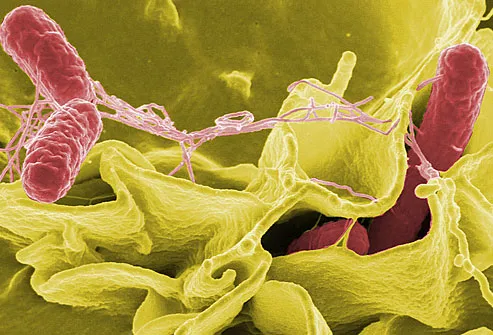| |||||
|
Salmonella Slideshow

1/8
What is Salmonella?
Salmonella is a nasty
bacterium that sometimes turns up in the food supply, including chicken,
tomatoes, peanuts, salsa, guacamole, and even pet food. It thrives in the
intestinal tracts of animals and humans and can cause food poisoning. Illnesses
range from mild to very serious infections that can kill vulnerable people. But
there are ways to protect yourself.
Shown
here is a color-enhanced, magnified view of salmonella bacteria invading human
cells.

1/8
Food Sources of Salmonella
Any raw food of animal
origin -- such as meat, poultry, milk and dairy products, eggs, and seafood --
and increasingly some fruits and vegetables may carry salmonella
bacteria. People should avoid eating raw or undercooked meat, poultry, or
eggs, along with unpasteurized dairy products. You should also pay close
attention to any recall notices and warnings involving foods that are not
usually associated with salmonella. The list also includes homemade foods made
with raw eggs, such as mayonnaise, cookie dough, and ice cream.

1/8
Can Cooking or Washing Help?
Thorough cooking can
kill salmonella. While it's always a good idea to rinse fruits and vegetables,
it may not get rid of salmonella, particularly during an outbreak -- it's best
just to throw any suspect produce away. Further, when health officials warn people
not to eat potentially contaminated food during an outbreak, that means you
shouldn't eat that food, cooked or not.

1/8
Food Safety Tips
The FDA recommends these
practices for all fruits and vegetables to prevent food poisoning:
·
Wash hands with soap and warm water before
and after handling them.
·
Wash produce thoroughly under running
water, not in a tub or sink.
·
Use a clean cutting board and utensils.
Don't let produce come into contact with other raw foods or surfaces they have
touched.

1/8
Non-Food Sources of Salmonella
Pets may carry
salmonella bacteria in their intestines, so their feces are a potential
concern. Certain pets, such as turtles, snakes and other reptiles, and chicks
and other birds are more likely to carry it. Always wash your hands thoroughly
with soap and warm water after coming into contact with any pet or their
droppings.

1/8
Salmonella in Baby Chicks
The CDC warns of
recurring salmonella outbreaks in baby chicks. One outbreak tends to recur
every spring, as parents buy chicks as Easter gifts for their kids. The CDC
warns parents not to do this. Kids under age 5 should never handle
baby chicks or ducks.

1/8
Salmonella Symptoms and Treatments
Symptoms of
salmonellosis include abdominal cramps, diarrhea, and fever that develop 12 to
72 hours after eating. Most people recover in four to seven days and don't
require treatment other than drinking plenty of fluids. People with severe
diarrhea may require intravenous fluids. Antibiotics are not always needed in
healthy people unless the salmonella infection has spread beyond the
intestines. Serious -- and potentially fatal -- cases are more likely in young
children, frail or elderly people, and people with weak immune systems.
This tool does not provide medical advice.

মন্তব্যসমূহ
একটি মন্তব্য পোস্ট করুন